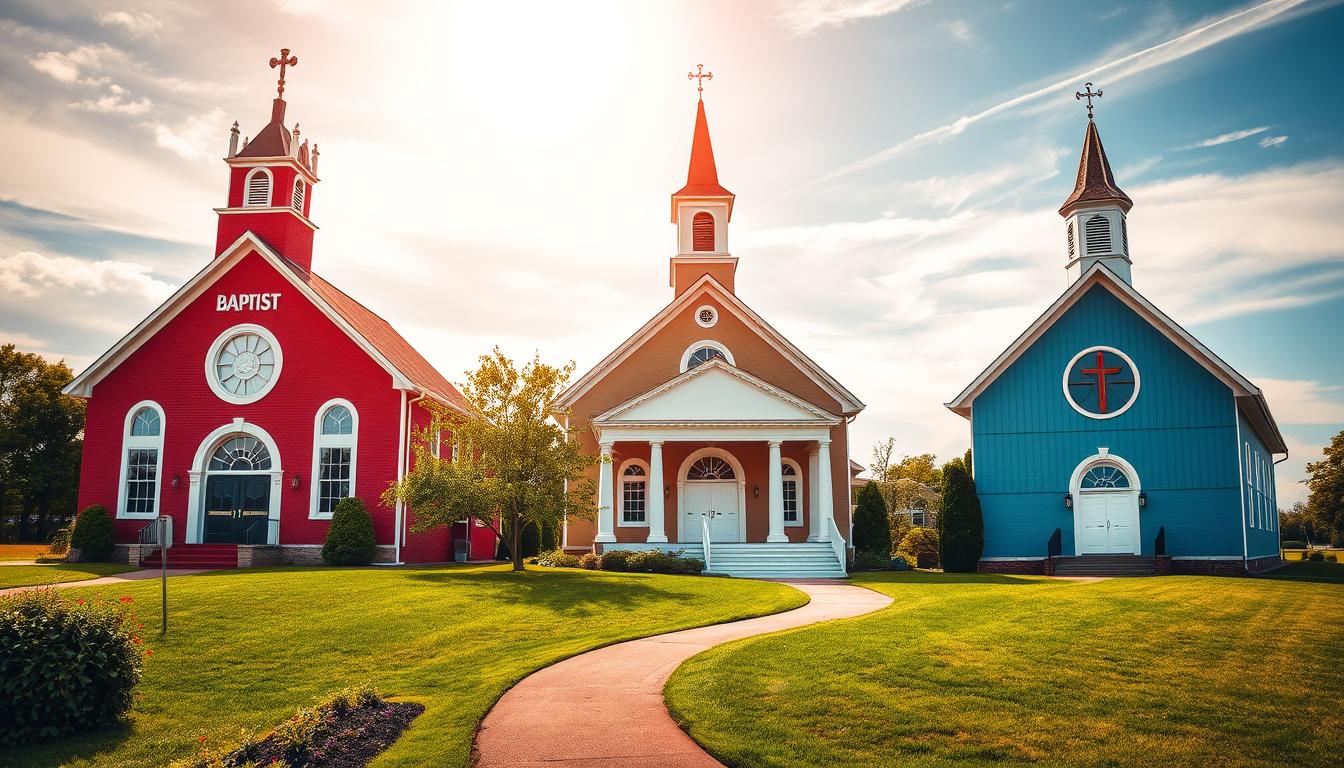In the world of Christianity, three big groups stand out: Baptist, Methodist, and Lutheran. Our son found out each has its own history, beliefs, and ways of worship and church leadership. Protestantism is a big part of America’s religious scene. Knowing the differences between these groups helps us understand Christianity better.
So, what makes Baptists, Methodists, and Lutherans unique? This guide will look into their histories, beliefs, and how they practice their faith. We’ll see how these Protestant groups differ.

Transform Your Faith Journey: Explore Our Engaging Bible Study eBooks
Key Takeaways
- Baptists are seen as the most conservative in Protestantism. They believe in fundamentalist views and local church freedom.
- Methodists started as a reform group in the Church of England in the 18th century. They are known for their wide range of beliefs.
- Lutherans follow Martin Luther’s teachings. They believe in the Bible’s power and salvation through faith alone.
- Baptists, Methodists, and Lutherans have different views on church leadership, sacraments, and important teachings.
- Learning about these differences gives us a deeper look into Protestant Christianity’s many forms.
Introduction: Christianity’s Major Denominations
Christianity is a diverse and multifaceted religion. It has many denominations and traditions that have grown over centuries. The main branches are the Eastern Orthodox, Roman Catholic, and Protestant traditions.
In the U.S., nearly 8 in 10 adults say they belong to Christianity. About 51.3% are Protestant, 23.9% are Catholic, and the rest belong to other Christian groups.
The Protestant tradition started with the Reformation movement. It has led to many denominations, each with its own beliefs, practices, and culture. Protestants, including groups like Adventism, Anabaptism, Anglicanism, and Lutheranism, make up over 600 million people.
The Eastern Orthodox Church has about 230 million followers, making up 11.9% of Christians. The Roman Catholic Church has over 1.3 billion members, about 50.1% of all Christians.
This article will explore the main differences in major Christian denominations. We’ll focus on Baptist, Methodist, and Lutheran traditions within Protestantism. These groups show the rich diversity of Christianity.
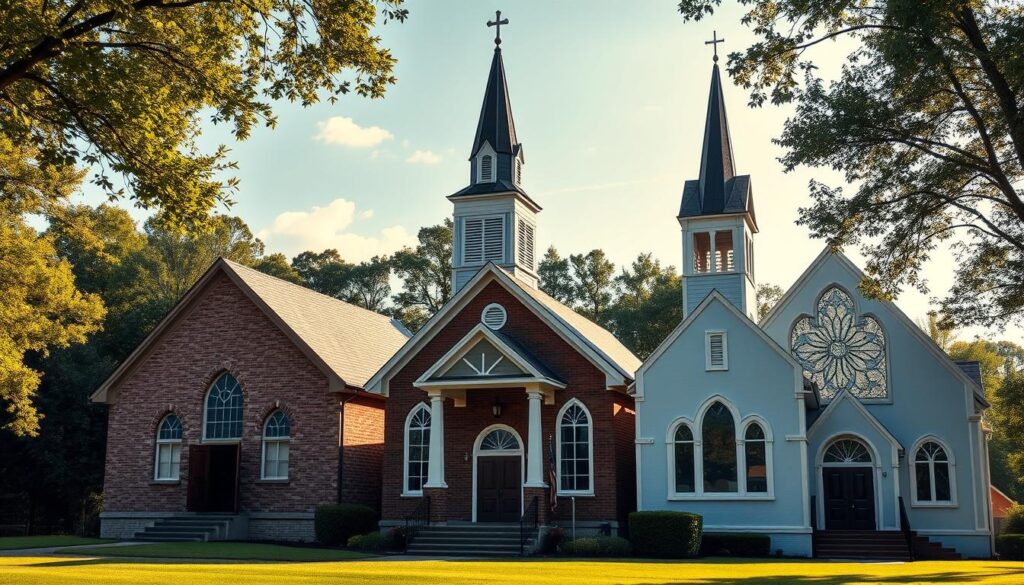
Eastern Orthodox Tradition
The Eastern Orthodox churches have a rich history. They are known by their nationality or location, like the Greek or Russian Orthodox. In 1054, a big split happened between the Eastern and Western churches. This was over a new phrase in the Nicene Creed, but also because of cultural and political reasons.
History and Origins
The Eastern Orthodox tradition goes back to the early Christian Church and the apostles’ teachings. It focuses on liturgical worship. This includes icons, incense, chanting, and the Eucharist.
Worship and Practices
Worship in the Eastern Orthodox Church centers on the liturgy. Both clergy and laity take part in the Eucharist. Icons, veneration of saints, and music are key parts of Orthodox worship.
Church Governance
The Eastern Orthodox Church is led by a hierarchy of bishops. They follow the apostles’ line. Bishops appoint male priests to lead local congregations in worship and care.
Key Beliefs and Distinctives
The Eastern Orthodox tradition values tradition to understand Scripture. It emphasizes the incarnation, resurrection, and union with God. Bishops are expected to be celibate, but priests can be married.
| Denomination | Total Membership | United States Membership |
|---|---|---|
| Roman Catholic | – | Almost 33,500,000 |
| Uniate Church | About 4.5 million | Around 450,000 |
| Episcopal Church | – | About 3 million communicant members |
| Lutherans | – | About 6 million communicant members, divided among 19 ecclesiastical bodies |
| Presbyterians | 10,893,000 globally | 3,986,000 members in the United States |
| Baptists | Around 21 million worldwide | About 17 million in the United States, including Southern Baptists, Negro Baptists, and minor sects |
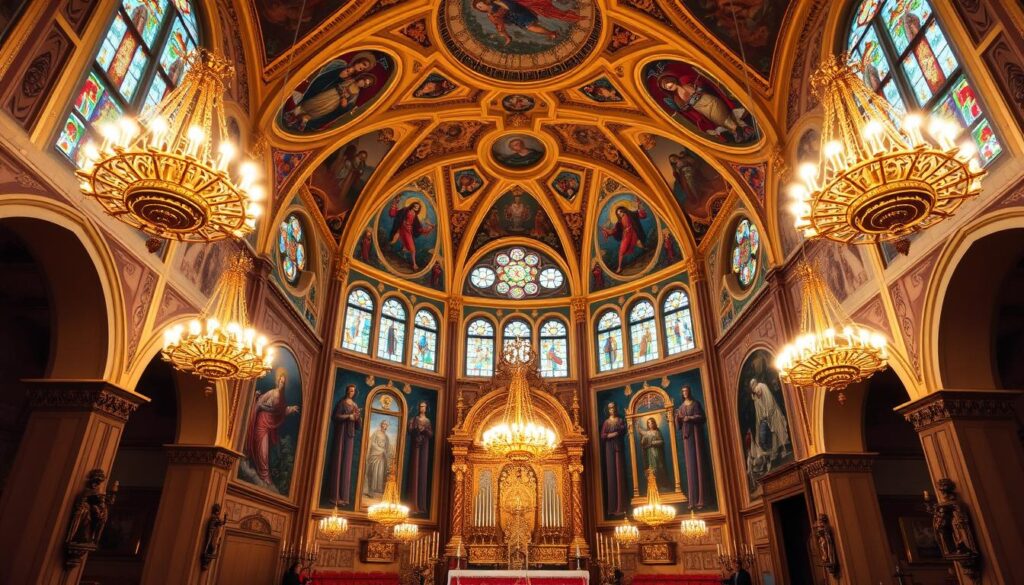
“The Eastern Orthodox tradition places a high priority on liturgical worship, with elements like icons, incense, chanting, and the Eucharist.”
Roman Catholic Tradition
The Roman Catholic Church has a long and rich history, starting in the early Christian era. Before the split in 1054, the Western church (Roman Catholics) grew theologically. Key figures like Augustine, Anselm, and Aquinas shaped its teachings.
Liturgical Worship
The Roman Catholic Church values liturgical worship a lot, like the Eastern Orthodox tradition. It uses statues, images, incense, and celebrates the Eucharist. This is at the heart of Catholic beliefs.
Organizational Structure
The church’s authority lies with bishops and male priests. At the top is the pope, seen as the church’s key human leader.
Doctrinal Emphases
Catholic theology focuses on seven sacraments and the Eucharist’s transubstantiation. It believes salvation comes through Christ’s righteousness. This is different from Protestant belief in justification by faith alone.
| Denomination | Percentage of Adult Population |
|---|---|
| Catholics | 23.9% |
| Protestants (overall) | 51.3% |
| Evangelical Protestants | 26.3% |
| Mainline Protestants | 18.1% |
| Historically Black Protestants | 6.9% |
The Roman Catholic Church stands out with its history, worship, structure, and beliefs. Its impact on Christianity is still strong today.

The Protestant Reformation
The Protestant Reformation was a big change in the 16th century. It challenged the old Catholic Church’s authority and teachings. Leaders like Martin Luther wanted to fix what they saw as wrong practices in the Church.
The Reformation is known for the five solas. These are sola Scriptura (Scripture alone), sola fide (faith alone), sola gratia (grace alone), solus Christus (Christ alone), and soli Deo gloria (the glory of God alone). These ideas put the Bible first, said faith in Christ saves us, and God is in charge. They opposed Catholic views on tradition, works, and the Church’s role.
This movement led to many Protestant churches, each with its own beliefs and ways of doing things. You have Lutheranism, Calvinism, Anglicanism, and Anabaptism, among others. They disagree on scripture, sacraments, and church rules.
“The Reformation was a struggle to recover the gospel of grace in all its purity and fullness.” – R.C. Sproul
The Protestant Reformation’s impact is still felt today. It brought diversity to Christianity and made the Bible and Christ central in Protestant beliefs. Now, Protestant Christianity has over 900 million followers worldwide.
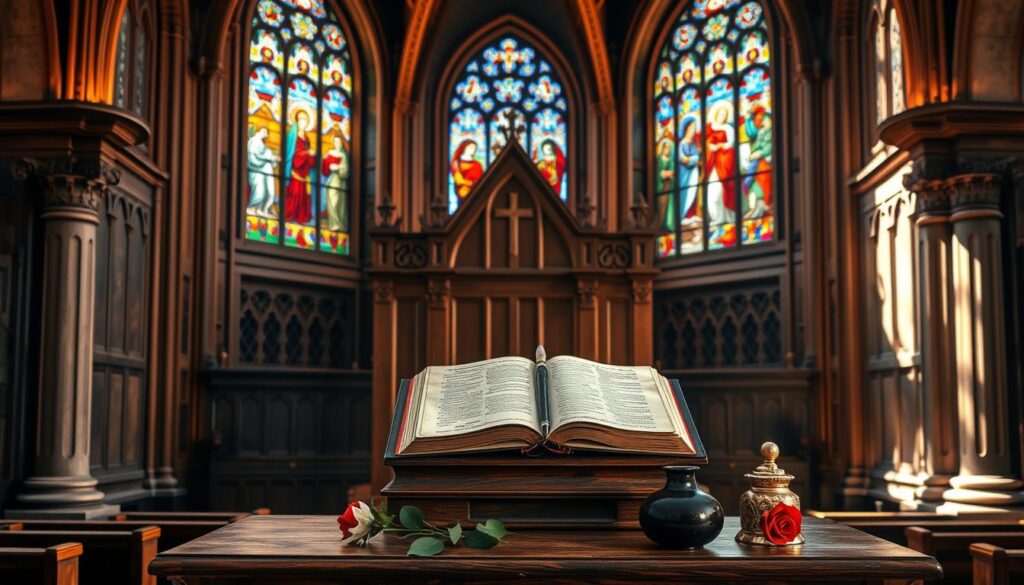
Anglican Communion
The Anglican Communion is a worldwide group of Christian churches. They share a common heritage and tradition. It started in the 16th century Protestant Reformation. The Church of England split from the Roman Catholic Church under King Henry VIII.
Origins and Separation
The Church of England separated from Rome in 1534. This was the start of the Anglican Communion. The goal was for more autonomy and theological reform in the English church.
Over time, the Anglican Communion grew worldwide. It established sister churches in many countries, like the Episcopal Church in the United States.
Worship Services
Anglican worship is formal and liturgical, based on the Church of England’s traditions. Services include Scripture readings, creeds, and the Eucharist, or Holy Communion. The Book of Common Prayer is key, uniting worship across the communion.
Church Polity
The Anglican Communion has a hierarchical structure, like the Roman Catholic Church. The Archbishop of Canterbury is the symbolic head and senior bishop. Below him, regional churches are led by bishops, overseeing priests and deacons in local congregations.
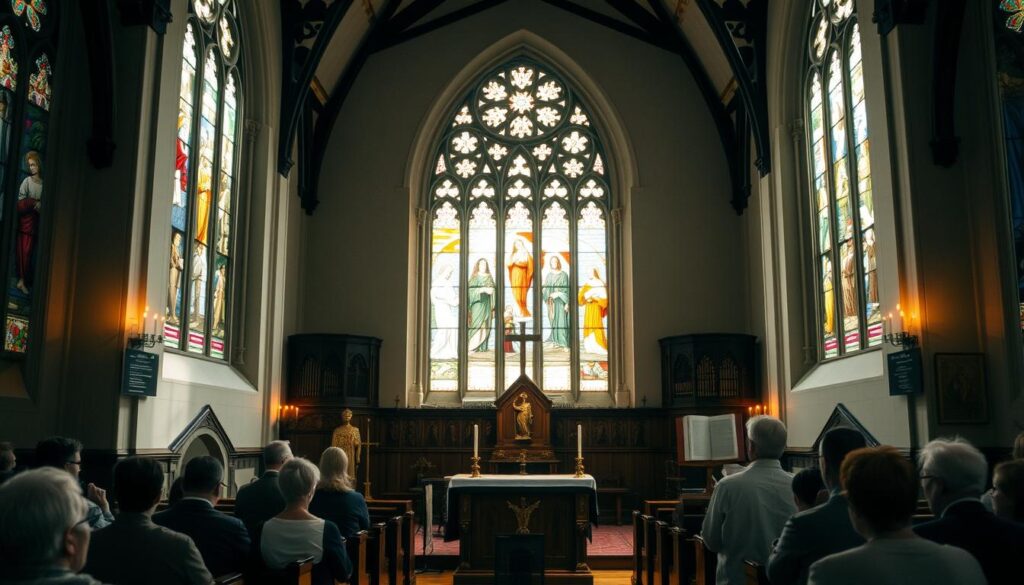
The Anglican Communion blends Reformed and Catholic traditions, finding a middle ground. As a global communion, it faces complex issues. It seeks unity while embracing diversity.
Lutheranism
Lutheranism is a branch of Protestant Christianity that follows Martin Luther’s teachings. It has a rich history and unique beliefs. At its core, Lutheranism believes in salvation by God’s grace alone, through faith in Jesus Christ alone, as shown in Scripture alone.
Martin Luther’s Teachings
Martin Luther, the founder of Lutheranism, challenged the Catholic Church in the 16th-century Protestant Reformation. His ideas, like the importance of Scripture and the priesthood of all believers, shaped the Lutheran tradition.
Lutheran Church Governance
Lutheran churches have different governance structures. Some have an episcopal structure with bishops, while others have a more local and regional focus. In the United States, the Lutheran Church—Missouri Synod (LCMS) and the Evangelical Lutheran Church in America (ELCA) are the main denominations. They differ on the Bible’s authority.
Core Lutheran Beliefs
Lutherans see baptism as a way God creates or strengthens faith. They baptize people of all ages, from infants to adults. They also believe in the true presence of Christ in the Eucharist, or communion.
The Book of Concord, published in 1580, outlines Lutheranism’s core beliefs. The Augsburg Confession, presented in 1530, is seen as the basic definition of Lutheranism.
Lutherans believe in salvation by God’s grace alone through faith in Jesus Christ alone. They believe faith can be created in a person’s heart by the Holy Spirit through God’s Word. Baptism is seen as a powerful means of grace, granting faith and forgiveness of sins.
| Denomination | Membership | Theological Stance |
|---|---|---|
| Lutheran Church-Missouri Synod (LCMS) | Around 2 million members | Conservative, supporting traditional marriage and not ordaining non-heterosexual individuals |
| Evangelical Lutheran Church in America (ELCA) | Approximately 4 million members | Endorses same-sex marriage and the ordination of non-heterosexual individuals |
| Episcopal Church in the United States | Roughly 2 million members | Diverse with a variety of beliefs and practices, often associated with social and theological liberalism |
“Lutherans believe that when an infant is baptized, God creates faith in the infant’s heart, even though it may not yet be verbally expressed or articulated. The faith created in infant baptism is believed to be real and present, needing to be nurtured through God’s Word.”
In summary, Lutheranism is a distinct branch of Protestant Christianity. It follows Martin Luther’s teachings, emphasizing salvation by grace alone, the authority of Scripture, and the importance of baptism and communion.
Baptist vs Methodist vs Lutheran: Key Differences
Protestants share common roots, but Baptist, Methodist, and Lutheran have big differences. These differences are key for talking and relating with others from these Protestant groups.
Baptists are the second-largest Christian group in the U.S., after Catholics. They don’t have creeds or confessions. This leads to many different beliefs, causing confusion.
Lutherans, especially the Lutheran Church—Missouri Synod (LCMS), focus a lot on the Bible and Lutheran Confessions. LCMS pastors must agree that the Lutheran Confessions explain the Bible correctly. They believe the Bible is perfect, unlike the more liberal Evangelical Lutheran Church in America (ELCA).
Methodists believe in the mix of grace and works for salvation. This is different from Baptists and Lutherans, who focus on grace alone through faith alone.
These groups also differ in worship, church rules, and how they view sacraments. For example, LCMS only lets members of certain synods take communion, while ELCA is more open.
Knowing these differences helps us understand the Protestant world better. It also helps us talk and connect with others from different traditions.
“The book ‘A Lutheran Looks at Baptists’ by Eric S. Hartzell is 78 pages long, providing insights into the differences between these two Protestant denominations.”
Baptist Churches
Baptist churches are a big part of the Christian world in the United States, making up about 15% of the population. They are the second-largest Christian group in the country. Their beliefs and practices make them stand out from other Protestant churches.
They believe in the Priesthood of All Believers and adult believer’s baptism. This sets them apart from others.
History and Beginnings
The Baptist movement started in the early 17th century. The first Baptist church was founded in England in 1609. It was a reaction against the Church of England’s excesses.
They valued individual freedom and the power of the local church. This has been key to Baptist history.
Worship and Practices
Baptist worship is simple, with a focus on the sermon. Hymns, prayers, and testimonies are also important. The whole congregation gets involved.
They believe in full-immersion baptism for adult believers. This is different from infant baptism.
Beliefs and Doctrines
Baptists have different views, from Arminian to Calvinist. But they all believe in the inerrancy of Scripture. They see salvation as a gift from Christ.
They don’t believe in the Real Presence in communion. Instead, they see it as a symbol of Christ’s body and blood.
“The Baptist church prides itself on not having any official creeds or confessions, allowing for a wide diversity of teachings among Christian churches.”
Despite their differences, Baptists value the local church’s autonomy. They believe in the Priesthood of All Believers. And they see Scripture as central to their faith.
Methodist Churches
Methodism started in the 18th century as a reform within the Church of England. John Wesley, an Anglican priest, led this movement. Today, Methodist churches have over 80 million followers worldwide. They believe in traditional Christian teachings and Protestant ideas like the Bible’s importance for salvation.
Origins and Founders
The Methodist movement began in Anglicanism in the 18th century. John and Charles Wesley led a revival focusing on personal conversion and charity. Their theology, known as Arminianism, differs from Calvinism by believing salvation is possible for all.
Worship Styles
Methodist worship varies from modern praise services to traditional liturgies. It includes special events like lovefeasts and watchnight services. These practices reflect the denomination’s rich heritage.
Theological Perspectives
Wesleyan theology is key to Methodist beliefs. It emphasizes faith’s power to transform and the process of sanctification. Methodist churches see the Bible as their main guide, but also value tradition, reason, and experience.
Methodism is known for its focus on charity and helping the needy. It also values living a simple life and attending class meetings.
In recent years, the United Methodist Church has changed its views on alcohol. In 1968, it dropped the rule for clergy to abstain. Yet, it still encourages not drinking as a sign of God’s love. Many U.S. United Methodists, however, enjoy drinking occasionally.
The United Methodist Church works with other denominations through partnerships. These partnerships aim for unity, recognizing sacraments and ministerial orders, and allowing clergy to serve across denominations.
Lutheran Churches
The Lutheran church in the United States has two main sides: conservative and modernist. The Lutheran Church-Missouri Synod is the biggest conservative group. On the other hand, the Evangelical Lutheran Church in America leans more towards modernism. Yet, all Lutherans agree on core Christian beliefs and Martin Luther’s teachings.
Distinct Lutheran Theology
Lutheranism started with Martin Luther’s ideas. It began as a negative term but is now seen as a positive one. Lutherans believe in faith alone for salvation and God’s grace alone.
They follow the Bible as the only true word of God. Baptism is seen as the first step into Christianity, often for infants. Communion is believed to have Christ’s presence in a special way, even though the bread and wine don’t actually become His body and blood.
Lutheran churches have different ways of governing themselves. They also have varied views on marriage, divorce, and other life issues. Some Lutherans even support war if it’s just, and their views on the afterlife are not clear.
| Key Characteristics | Lutheran Conservatives | Lutheran Modernists |
|---|---|---|
| Theological Orientation | Theologically conservative | Theologically modernist |
| Largest Denomination | Lutheran Church-Missouri Synod | Evangelical Lutheran Church in America |
| Beliefs | Uphold historic Christian beliefs and Martin Luther’s theology | Uphold historic Christian beliefs and Martin Luther’s theology |
| Church Governance | Varies widely | Varies widely |
In summary, Lutherans in the United States are split between conservative and modernist views. The Lutheran Church-Missouri Synod is the biggest conservative group. The Evangelical Lutheran Church in America is more modernist. Yet, all Lutherans agree on key teachings from Martin Luther.
Comparing Sacraments and Practices
The Baptist, Methodist, and Lutheran denominations have different views on sacraments and worship. Baptists see only two sacraments: baptism and communion. Methodists and Lutherans, however, believe in more, like confirmation, marriage, and ordination.
Lutherans believe Christ is truly present in the Eucharist, unlike Baptists and Methodists. Also, Lutherans see communion as a sacrament more than Methodists do.
Worship styles and the importance of liturgy and tradition vary among these groups. Lutherans still practice private confession. This tradition is less common in Baptist and Methodist churches.
When it comes to baptism, Lutherans and Methodists mostly practice infant baptism. They see it as a replacement for Jewish circumcision. Baptists, however, focus on believer’s baptism and view the Lord’s Supper as a memorial.
The sacraments and worship practices of these denominations show their unique theological views. These views are shaped by their beliefs on grace, Scripture, and tradition in Christian life.
“The sacraments are not just symbolic actions, but rather tangible means through which God conveys His grace to believers.”
– Lutheran Theologian, Martin Luther
Doctrinal Distinctions
Baptist, Methodist, and Lutheran churches have different views on important teachings. Baptists believe people must choose to accept Christ to be saved. Lutherans say salvation comes from God’s grace alone, and we can’t save ourselves.
Baptists value human reason and the Bible equally. Lutherans believe reason should follow the Bible’s teachings. Baptists see good deeds as obeying God. Lutherans see them as a thank you for God’s grace.
Conversion and Salvation
Baptists think you must choose to accept Christ to be saved. Lutherans believe God’s grace is the only way to salvation. They say we can’t save ourselves.
Scripture and Tradition
Baptists believe the Bible is the only guide for faith and practice. Lutherans also value the Bible but also tradition and reason in understanding it.
Grace and Works
Baptists see good deeds as showing faith and obedience. Lutherans believe salvation comes from God’s grace. They think good deeds are a natural response to that grace, not a way to earn it.
These differences show how Baptist, Methodist, and Lutheran churches have unique views. They reflect the rich variety in Protestantism.
Church Governance and Authority
The Baptist, Methodist, and Lutheran denominations have different ways of governing their churches and deciding who has authority. While many churches follow an Episcopal system, Baptists believe in the freedom of each local church. They think that the church should make its own decisions, with little help from higher bodies.
Methodists have a system where bishops guide different areas, having a big say in things. Lutherans, however, mix things up a bit. They have both local and bigger groups making decisions together. In some churches, there are only a few roles, like elder and pastor, to help run things.
Baptist history is tied to the Anabaptist movement of 1525. They focus on adult baptism and believing in faith. Baptist churches are free to decide things on their own. They choose their pastors based on what they need.
Lutheranism started with Martin Luther in the early 1500s. They believe in being saved by faith alone. Like Lutherans, they also mix local and bigger groups in making decisions.
| Denomination | Church Governance | Pastoral Selection |
|---|---|---|
| Baptist | Congregational, autonomous local churches | Chosen by individual churches |
| Methodist | Episcopal, with bishops overseeing regions | Appointed by bishops |
| Lutheran | Mix of congregational and presbyterian, with regional and national synods | Chosen by local churches, with input from synods |
In summary, Baptists, Methodists, and Lutherans each have their own way of running their churches. This shows their unique histories and beliefs.
Conclusion
Baptists, Methodists, and Lutherans all started from the Protestant Reformation. Yet, they have grown into unique groups with their own beliefs and ways of doing things. The Lutheran church began in the early 1500s with Martin Luther’s ideas. Baptists, influenced by the Anabaptist movement, started in 1525 in Switzerland. For over 200 years, Baptists and Methodists have been big names in American Protestantism.
Knowing the differences between these groups is key for talking and getting along with people from different Christian backgrounds. Baptists are the biggest Protestant group in the U.S., making up about 15% of the population. They have many teachings, with some similarities and differences between different Baptist groups. Lutherans, meanwhile, have a mix of church governing styles and give power to synods.
By looking into their histories, beliefs, and church life, we can better understand the rich Christian faith in these denominations. Methodists focus on holiness, complete sanctification, and striving for perfection. Baptists, on the other hand, emphasize soul freedom, church purity, and spreading the word. Knowing these differences helps us see the variety in Protestantism.
FAQ
What are the key differences between Baptist, Methodist, and Lutheran denominations?
Baptist, Methodist, and Lutheran churches have different beliefs and practices. They disagree on Scripture, sacraments, and how to be saved. They also have different views on grace and works.
How do the Baptist, Methodist, and Lutheran denominations differ in their practices of the sacraments?
Baptists only see two sacraments: baptism and communion. Methodists and Lutherans believe in more, like confirmation and marriage. Lutherans believe in a real presence of Christ in communion, unlike Baptists and Methodists.
What are the key theological distinctions between the Baptist, Methodist, and Lutheran denominations?
Baptists believe in working with God to be saved. Lutherans say we can’t save ourselves. Baptists value reason and Scripture, while Lutherans say reason must follow God’s Word.
Baptists see good works as obeying God. Lutherans believe they are a response to God’s grace.
How do the Baptist, Methodist, and Lutheran denominations differ in their church governance and authority structures?
Baptists believe in local church independence. Methodists have bishops for regional areas. Lutherans have different systems, from bishops to congregational.
What are the historical origins and key beliefs of the Eastern Orthodox, Roman Catholic, and Protestant traditions?
The Eastern Orthodox churches split from Rome in 1054 over the Creed. They value liturgy and emphasize incarnation and resurrection. The Roman Catholic Church developed further, with seven sacraments and the doctrine of transubstantiation.
The Protestant Reformation aimed to correct medieval Catholic Church teachings. It was led by figures like Martin Luther.

